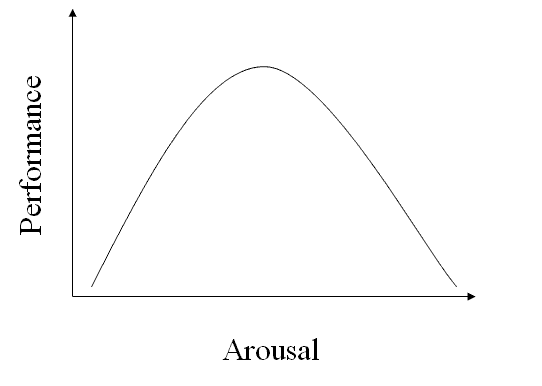Inverted U hypothesis
The Inverted U Hypothesis suggests that optimal performance occurs at an intermediate level of arousal while both low and high levels of arousal will result in impaired performance. This proposal is made based on the Yerkes-Dodson law (named after the researchers who discovered it) which predicts an inverted U-shaped function between arousal and performance (Yerkes, Dodson, 1908).
In sport, this means that a little excitement and stress associated with competition can have a positive effect, but a situation that is too stressful is detrimental. However, the optimal levels of arousal vary between people doing the same task. Even more, for the same person doing different tasks optimal levels of arousal may vary. However, in general one could expect that athletes may perform badly because they are over- or under-aroused. In addition, the optimum arousal levels tend to be lower for more complicated tasks.
The Inverted U Hypothesis is an appealing explanation for performance flaws. In many ways this explanation fits into the observations from sport performers but in reality is too simplistic.
In addition to what the Inverted U hypothesis predicts, it is important to consider that beginners usually need a greater amount of attention to the performance while an expert can perform the same skill more or less automatically. When the beginner has a high level of arousal he/she can get distracted and tends not to give the same amount of attention to the skill. This leads to the deterioration of performance.
Also, beginners tend to rely heavily on cues and signals within the environment to perform the right skills in the right situations and at the right moment. However, when arousal increases their focus on the essential cues and signal declines and they will lose concentration and become unable to react to the proper cues. Therefore novices normally perform better with lower levels of arousal than an expert would need.
Moreover, the optimum level of arousal can also vary in relation to the skill being performed. Sports that incorporate major muscle groups or gross skills such as weightlifting may benefit from having higher levels of arousal, whereas activities which incorporate finer skills and high coordination such as archery or gymnastics may benefit from lower levels of arousal.
Refernces:
Yerkes, R.M., & Dodson, J. D. (1908). The relation of strength of stimulus to rapidity of habit formation. Journal of Comparative Neurology and Psychology, 18, 459-482.
